Model 3298 Vortex Tube
Applications
- Cooling electronic controls
- Cooling machining operations
- Cooling CCTV cameras
- Setting hot melts
- Cooling soldered parts
- Cooling gas samples
- Electronic component cooling
- Cooling heat seals
- Cooling environmental chambers
Advantages
- No moving parts
- No electricity or chemicals
- Small, lightweight
- Low cost
- Maintenance free
- Instant cold air
- Durable - stainless steel
- Adjustable temperature
- Interchangeable generators
Accessories |
|
| Model | Description |
| 3905 | Cold Muffler for 2 through 8 SCFM (57 - 227 SLPM) Vortex Tube, Small Size |
| 3901 | Cold Muffler for 10 through 40 SCFM (283 - 1,133 SLPM) Vortex Tube, Medium Size |
| 3906 | Cold Muffler for 50 through 150 SCFM (1,416 - 4,248 SLPM) Vortex Tube, Large Size |
| 3903 | Hot Muffler for 2 through 40 SCFM (57 - 1,133 SLPM) Vortex Tube, Small & Medium Size |
| 3907 | Hot Muffler for 50 through 150 SCFM (1,416 - 4,248 SLPM) Vortex Tube, Large Size |
| 3909 | Generator Kit for 2 through 8 SCFM (57 - 227 SLPM) Vortex Tube, Small Size |
| 3902 | Generator Kit for 10 through 40 SCFM (283 - 1,133 SLPM) Vortex Tube, Medium Size |
| 3910 | Generator Kit for 50 through 150 SCFM (1,416 - 4,248 SLPM) Vortex Tube, Large Size |
|
Generator Kits ordered with a vortex tube include all generators for the specified tube. Permits setting the vortex tube for all capacities and styles. Generator Only —Specify capacity (SCFM) and style (“R” for max. refrigeration, “C” for max. cold temperature). Example: 15-R = 15 SCFM Generator for max. refrigeration 50-C = 50 SCFM Generator for max. cold temperature |
|
Vortex Tube Performance
The Vortex Tube Performance Charts below give approximate temperature drops (and rises) from inlet air temperature produced by a vortex tube set at each cold fraction. Assuming no fluctuation of inlet temperature or pressure, a vortex tube will reliably maintain temperature within ±1°F.
Pressure Supply |
Cold Fraction % |
||||||
| PSIG | 20 | 30 | 40 | 50 | 60 | 70 | 80 |
| 20 | 62 | 60 | 56 | 51 | 44 | 36 | 28 |
| 15 | 25 | 36 | 50 | 64 | 83 | 107 | |
| 40 | 88 | 85 | 80 | 73 | 63 | 52 | 38 |
| 21 | 35 | 52 | 71 | 92 | 117 | 147 | |
| 60 | 104 | 100 | 93 | 84 | 73 | 60 | 46 |
| 24 | 40 | 59 | 80 | 104 | 132 | 166 | |
| 80 | 115 | 110 | 102 | 92 | 80 | 66 | 50 |
| 25 | 43 | 63 | 86 | 113 | 143 | 180 | |
| 100 | 123 | 118 | 110 | 100 | 86 | 71 | 54 |
| 26 | 45 | 67 | 90 | 119 | 151 | 191 | |
| 120 | 129 | 124 | 116 | 104 | 91 | 74 | 55 |
| 26 | 46 | 69 | 94 | 123 | 156 | 195 | |
| Numbers in shaded area show temperature drop of cold air (°F). | |||||||
| Numbers in unshaded area show temperature rise of hot air (°F). | |||||||
Pressure Supply |
Cold Fraction % (METRIC) |
||||||
| BAR | 20 | 30 | 40 | 50 | 60 | 70 | 80 |
| 1.4 | 34.4 | 33.3 | 31.1 | 28.3 | 24.4 | 20 | 15.6 |
| 8.3 | 13.9 | 20 | 28.3 | 35.6 | 46.1 | 59.4 | |
| 2 | 40.9 | 39.6 | 37.1 | 33.8 | 29.2 | 24 | 18.1 |
| 9.8 | 16.4 | 24 | 33.3 | 42.6 | 54.6 | 69.5 | |
| 3 | 50.4 | 48.7 | 45.7 | 41.6 | 36 | 29.7 | 21.9 |
| 12 | 19.9 | 29.6 | 40.3 | 52.3 | 66.5 | 83.5 | |
| 4 | 56.9 | 54.7 | 50.9 | 46.1 | 40 | 32.9 | 25.1 |
| 13.2 | 21.9 | 32.4 | 43.9 | 57.1 | 72.5 | 91.2 | |
| 5 | 61.6 | 59 | 54.8 | 49.4 | 43 | 35.4 | 26.9 |
| 13.7 | 23.3 | 34.2 | 46.5 | 60.9 | 77.2 | 97.1 | |
| 6 | 65.4 | 62.7 | 58.2 | 52.7 | 45.6 | 37.6 | 28.6 |
| 14.1 | 24.3 | 35.8 | 48.6 | 63.9 | 81 | 102.1 | |
| 7 | 68.6 | 65.8 | 61.4 | 55.7 | 48 | 39.6 | 30 |
| 14.4 | 25.1 | 37.3 | 50.2 | 66.3 | 84.2 | 106.3 | |
| 8 | 71.1 | 68.2 | 63.8 | 57.3 | 50 | 40.8 | 30.4 |
| 14.4 | 25.4 | 38.1 | 51.8 | 67.9 | 86.1 | 107.9 | |
| Numbers in shaded area show temperature drop of cold air (°C). | |||||||
| Numbers in unshaded area show temperature rise of hot air (°C). | |||||||
Back Pressure: The performance of a vortex tube deteriorates with back pressure on the cold air exhaust. Low back pressure, up to 2 PSIG (.1 BAR), will not change performance. 5 PSIG (.3 BAR) will change performance by approximately 5°F (2.8°C).
Filtration: The use of clean air is essential, and filtration of 25 microns or less is recommended. EXAIR filters contain a five micron element and are properly sized for flow.
Inlet Air Temperature: A vortex tube provides a temperature drop from supply air temperature (see Performance Charts above). Elevated inlet temperatures will produce a corresponding rise in cold air temperatures.
Noise Muffling: EXAIR offers mufflers for both the hot and cold air discharge. Normally, muffling is not required if the cold air is ducted.
Regulation: For best performance, use line pressures of 80 to 110 PSIG (5.5 to 7.6 BAR). Maximum pressure rating is 250 PSIG (17.2 BAR), minimum 20 PSIG (1.4 BAR).
Vortex Tube Specifications
3200 Series Vortex Tube Specifications |
||||||
| 3200 series Vortex Tubes optimize temperature drop and airflow to produce maximum cooling power or Btu/hr. (Watts). Specify 3200 series Vortex Tubes for most general cooling applications. | ||||||
| Model # | SCFM* | SLPM* | Btu/hr.** | Watts** | Size | dBA*** |
| 3202 | 2 | 57 | 135 | 40 | Small | 68 |
| 3204 | 4 | 113 | 275 | 80 | Small | 70 |
| 3208 | 8 | 227 | 550 | 162 | Small | 76 |
| 3210 | 10 | 283 | 650 | 191 | Medium | 80 |
| 3215 | 15 | 425 | 1,000 | 293 | Medium | 81 |
| 3225 | 25 | 708 | 1,700 | 498 | Medium | 82 |
| 3230 | 30 | 850 | 2,000 | 586 | Medium | 84 |
| 3240 | 40 | 1,133 | 2,800 | 821 | Medium | 88 |
| 3250 | 50 | 1,416 | 3,400 | 997 | Large | 94 |
| 3275 | 75 | 2,124 | 5,100 | 1,494 | Large | 96 |
| 3298 | 100 | 2,832 | 6,800 | 1,993 | Large | 96 |
| 3299 | 150 | 4,248 | 10,200 | 2,989 | Large | 97 |
|
* SCFM (SLPM) at 100 PSIG (6.9 BAR) Inlet Pressure ** Btu/hr. (Watts) Cooling Capacity at 100 PSIG (6.9 BAR) *** Noise levels taken with hot and cold mufflers installed. |
||||||
3400 Series Vortex Tube Specifications |
||||||
| 3400 series Vortex Tubes provide lowest cold air temperatures, but at low cold airflow (when less than a 50% cold fraction is used). Specify 3400 series Vortex Tubes only where temperatures below 0° (-18°C) are desired. | ||||||
| Model # | SCFM* | SLPM* | Btu/hr.** | Watts** | Size | dBA*** |
| 3402 | 2 | 57 | -------- | -------- | Small | 67 |
| 3404 | 4 | 113 | -------- | -------- | Small | 69 |
| 3408 | 8 | 227 | -------- | -------- | Small | 75 |
| 3410 | 10 | 283 | -------- | -------- | Medium | 78 |
| 3415 | 15 | 425 | -------- | -------- | Medium | 80 |
| 3425 | 25 | 708 | -------- | -------- | Medium | 82 |
| 3430 | 30 | 850 | -------- | -------- | Medium | 84 |
| 3440 | 40 | 1,133 | -------- | -------- | Medium | 87 |
| 3450 | 50 | 1,416 | -------- | -------- | Large | 93 |
| 3475 | 75 | 2,124 | -------- | -------- | Large | 96 |
| 3498 | 100 | 2,832 | -------- | -------- | Large | 96 |
| 3499 | 150 | 4,248 | -------- | -------- | Large | 96 |
|
* SCFM (SLPM) at 100 PSIG (6.9 BAR) Inlet Pressure ** Not Applicable. 3400 series Vortex Tubes are not normally used in air conditioning applications. ***Noise levels taken with hot and cold mufflers installed. |
||||||
Vortex Tube Dimensions |
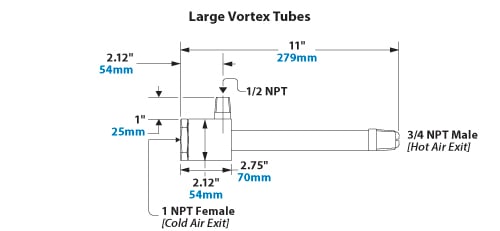 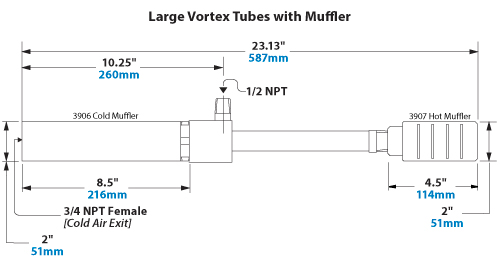 |
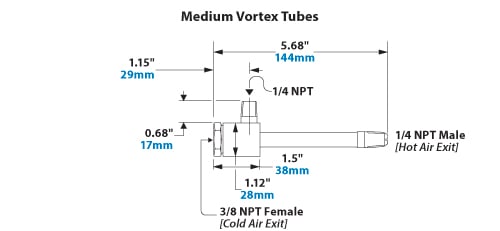 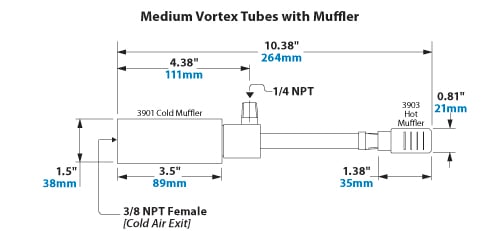 |
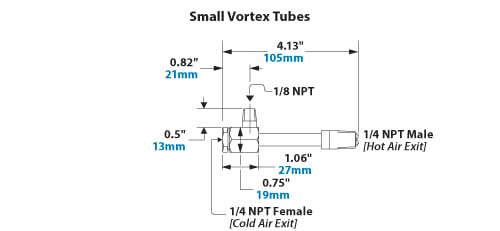 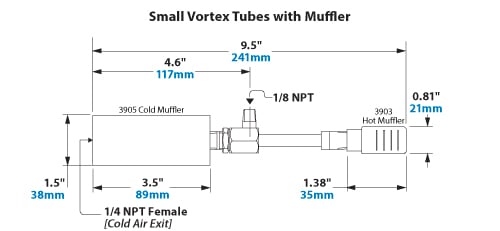 |
How Vortex Tubes Work |
 |
Compressed air, normally 80-100 PSIG (5.5 - 6.9 BAR), is ejected tangentially through a generator into the vortex spin chamber. At up to 1,000,000 RPM, this air stream revolves toward the hot end where some escapes through the control valve. The remaining air, still spinning, is forced back through the center of this outer vortex. The inner stream gives off kinetic energy in the form of heat to the outer stream and exits the vortex tube as cold air. The outer stream exits the opposite end as hot air. |
Vortex Tube Styles
EXAIR Products Using Vortex Tubes
Over the years, the basic vortex tube has been used in virtually hundreds of industrial cooling applications. A few have become so popular as to warrant the development of an “applied product” designed to suit the specific application. These products include the Adjustable Spot Cooler, Mini Cooler, Cold Gun and Cabinet Coolers.
High Temperatures
High temperature vortex tubes for ambient temperatures up to 200°F (93°C) are available. Standard vortex tubes are for ambient temperatures up to 125°F (52°C). Contact an Application Engineer at 1-800-903-9247 for more details.
Preset Vortex Tubes
EXAIR can provide vortex tubes preset to any combination of flow and temperature desired. To prevent tampering with the desired setting, a drilled orifice that replaces the adjustable hot valve is available. For more information, please contact an Application Engineer.
Selecting the Right Vortex Tube
EXAIR Vortex Tubes are available in three sizes. Each size can produce a number of flow rates, as determined by a small internal part called a generator. If Btu/hr. (Watts) requirements, or flow and temperature requirements are known, simply select the appropriate vortex tube according to the specification information on the Specifications table or the Performance charts shown in SPECIFICATIONS above.
Keep in mind that the vortex generators are interchangeable. If, for example, a Model 3215 Vortex Tube does not provide sufficient cooling, you need only change generators within the vortex tube to upgrade the flow rate from 15 to 25, 30 or 40 SCFM (425 to 708, 850 or 1,133 SLPM).
-
 Model 3298 Vortex Tube (100 SCFM)
Model 3298 Vortex Tube (100 SCFM)


